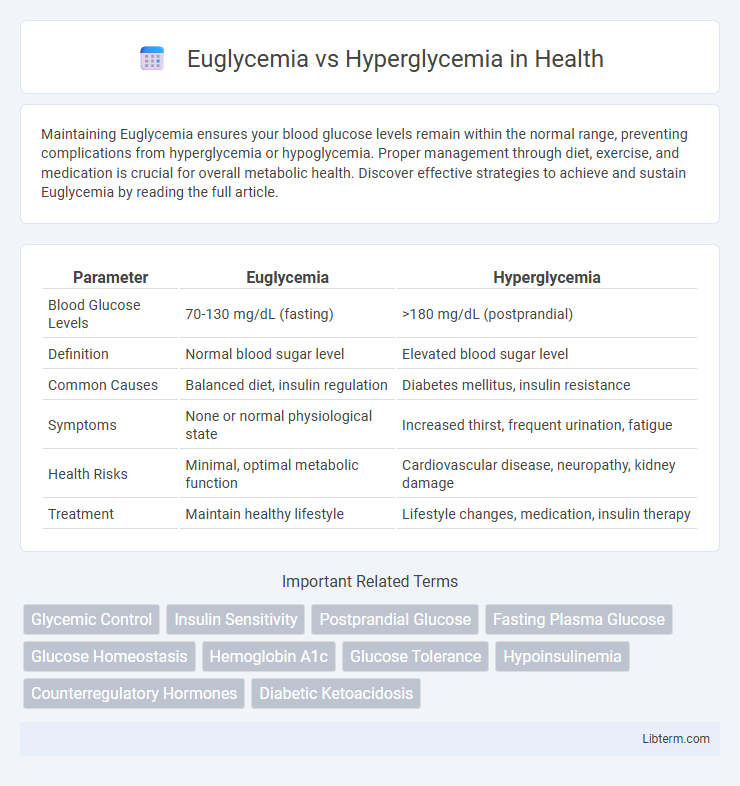Maintaining Euglycemia ensures your blood glucose levels remain within the normal range, preventing complications from hyperglycemia or hypoglycemia. Proper management through diet, exercise, and medication is crucial for overall metabolic health. Discover effective strategies to achieve and sustain Euglycemia by reading the full article.
Table of Comparison
| Parameter | Euglycemia | Hyperglycemia |
|---|---|---|
| Blood Glucose Levels | 70-130 mg/dL (fasting) | >180 mg/dL (postprandial) |
| Definition | Normal blood sugar level | Elevated blood sugar level |
| Common Causes | Balanced diet, insulin regulation | Diabetes mellitus, insulin resistance |
| Symptoms | None or normal physiological state | Increased thirst, frequent urination, fatigue |
| Health Risks | Minimal, optimal metabolic function | Cardiovascular disease, neuropathy, kidney damage |
| Treatment | Maintain healthy lifestyle | Lifestyle changes, medication, insulin therapy |
Understanding Euglycemia: Definition and Importance
Euglycemia refers to maintaining normal blood glucose levels, typically ranging between 70 to 100 mg/dL when fasting, crucial for optimal cellular function and metabolic balance. Proper regulation of euglycemia prevents the onset of hyperglycemia, a condition characterized by elevated blood sugar levels that can lead to diabetes complications such as neuropathy, retinopathy, and cardiovascular disease. Understanding and sustaining euglycemia is vital for managing energy homeostasis and reducing the risk of metabolic disorders.
What is Hyperglycemia? Key Characteristics
Hyperglycemia is characterized by abnormally high blood glucose levels, typically above 130 mg/dL fasting or over 180 mg/dL postprandial. Key indicators include frequent urination, increased thirst, blurred vision, and fatigue, often linked to diabetes mellitus due to impaired insulin function. Persistent hyperglycemia can lead to serious complications such as diabetic ketoacidosis, neuropathy, and cardiovascular disease.
Blood Glucose Levels: Normal vs Elevated Ranges
Euglycemia refers to normal blood glucose levels, typically ranging between 70 and 100 mg/dL when fasting, indicating optimal metabolic function. Hyperglycemia occurs when blood glucose levels rise above the normal range, often defined as fasting blood sugar levels over 125 mg/dL or postprandial levels exceeding 180 mg/dL, signaling impaired glucose regulation. Consistently elevated glucose concentrations can lead to complications such as diabetic ketoacidosis and cardiovascular issues.
Causes of Euglycemia in Healthy Individuals
Euglycemia in healthy individuals is primarily maintained by the balanced interplay of insulin secretion and glucose uptake by tissues, avoiding abnormal blood glucose fluctuations. Key causes include proper pancreatic beta-cell function, effective insulin sensitivity in muscle and adipose tissues, and adequate hepatic glucose production regulation. Lifestyle factors such as regular physical activity, a balanced diet, and normal body weight also contribute significantly to sustaining euglycemia.
Common Triggers of Hyperglycemia
Common triggers of hyperglycemia include excessive carbohydrate intake, physical inactivity, illness or infection, and stress, leading to elevated blood glucose levels above the normal Euglycemia range of 70-130 mg/dL. Other factors such as missed insulin doses, certain medications like corticosteroids, and hormonal changes can also cause hyperglycemia by impairing glucose metabolism. Monitoring these triggers is essential for maintaining blood sugar control and preventing complications related to chronic hyperglycemia.
Symptoms: Euglycemia vs Hyperglycemia
Euglycemia refers to normal blood glucose levels, typically ranging between 70 and 100 mg/dL in fasting conditions, where individuals usually experience no symptoms. Hyperglycemia, characterized by blood glucose levels exceeding 180 mg/dL postprandially or consistently above 126 mg/dL fasting, manifests symptoms such as increased thirst, frequent urination, blurred vision, fatigue, and headaches. Persistent hyperglycemia can lead to severe complications including diabetic ketoacidosis, neuropathy, and retinopathy if left untreated.
Health Risks Associated with Hyperglycemia
Hyperglycemia, characterized by elevated blood glucose levels above 130 mg/dL fasting, poses significant health risks including diabetic ketoacidosis, cardiovascular disease, and neuropathy. Persistent hyperglycemia damages blood vessels, increasing the risk of retinopathy, kidney failure, and stroke in individuals with diabetes mellitus. Maintaining euglycemia, or normal blood glucose levels between 70-130 mg/dL, is essential for preventing these complications and promoting overall metabolic health.
Monitoring Blood Glucose for Optimal Control
Monitoring blood glucose levels is crucial for distinguishing between euglycemia, a state of normal blood sugar typically ranging from 70 to 130 mg/dL before meals, and hyperglycemia, defined as blood glucose levels exceeding 180 mg/dL postprandially. Consistent use of glucose monitoring devices allows for timely adjustments in insulin, diet, and physical activity to maintain optimal glycemic control and prevent complications. Real-time data from continuous glucose monitors (CGMs) provide critical insights into glucose variability, enabling personalized management strategies to sustain euglycemia and reduce the risk of chronic hyperglycemia-related damage.
Preventive Strategies for Maintaining Euglycemia
Maintaining euglycemia involves consistent monitoring of blood glucose levels and adhering to a balanced diet rich in fiber and low in simple sugars to prevent hyperglycemia. Regular physical activity improves insulin sensitivity, thereby reducing the risk of elevated blood glucose. Timely administration of prescribed medications such as insulin or oral hypoglycemics ensures stable glucose control and prevents long-term complications associated with hyperglycemia.
Treatment Approaches: Managing Hyperglycemia
Treatment of hyperglycemia primarily involves lifestyle modifications such as a balanced diet rich in fiber and low in simple sugars combined with regular physical activity to improve insulin sensitivity. Pharmacological interventions include the use of oral hypoglycemic agents like metformin and sulfonylureas, or insulin therapy in cases of severe hyperglycemia or type 1 diabetes. Continuous glucose monitoring and patient education on recognizing symptoms and managing blood glucose levels are critical for preventing complications associated with sustained hyperglycemia.
Euglycemia Infographic

 libterm.com
libterm.com